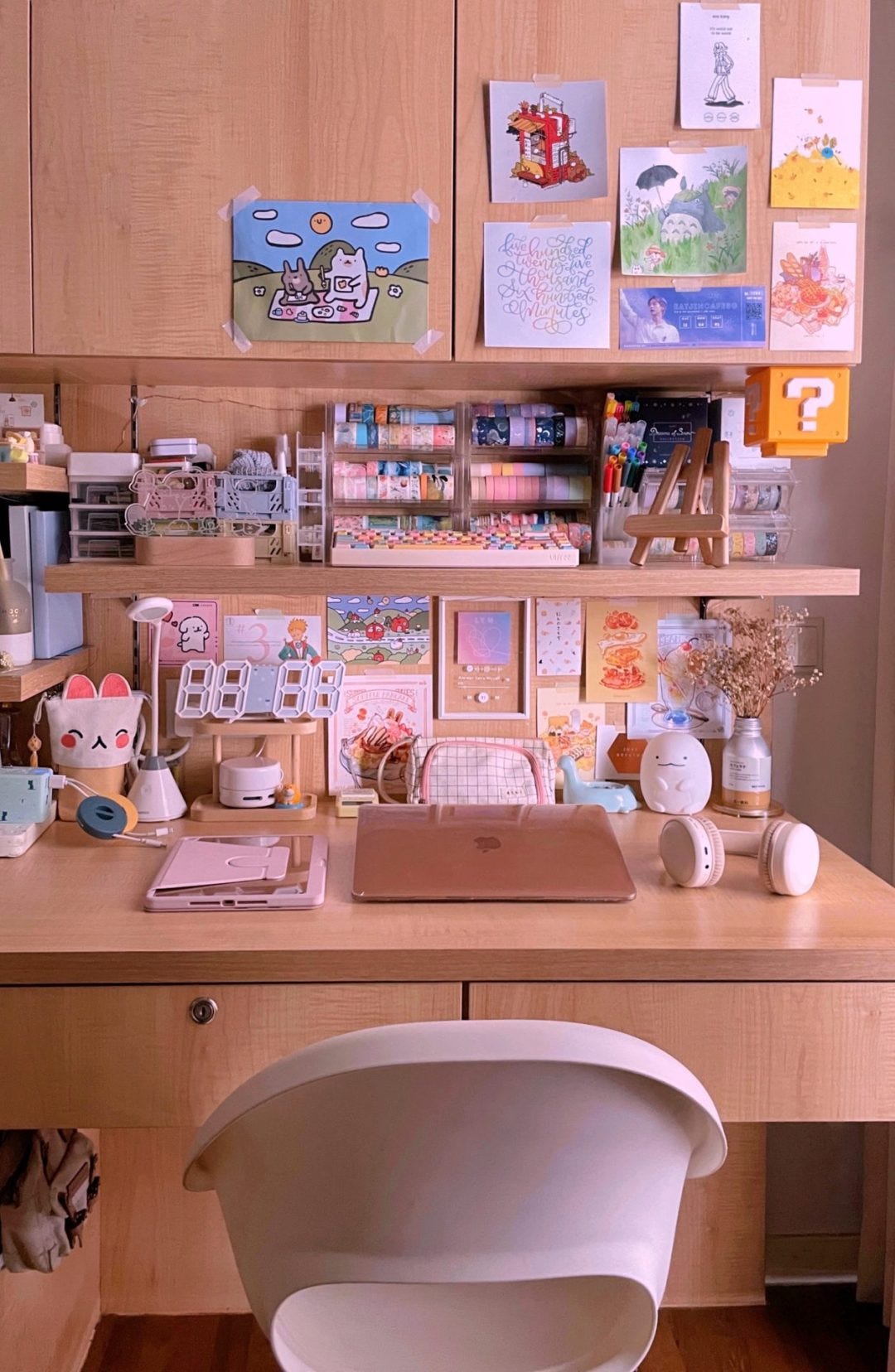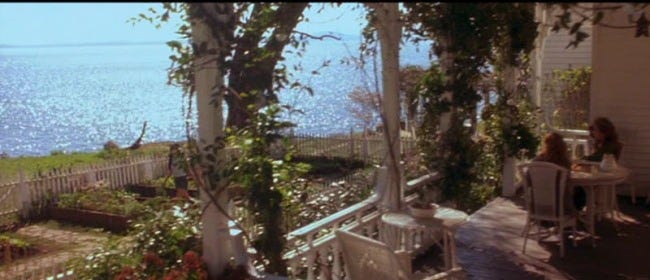The cozy fiction trend has crested, although I’m sure the fall season will cause sales to tick up for a few months. So I have a lukewarm take for you. Or rather, a confession: “cozy” fiction just doesn’t do it for me.
At least the fiction labeled as such is a miss for this cynic. I’ve tried the short and sweet speculative novels so many people adore and I feel no warm fuzzies. Their utopian visions leave me cold. The sci-fi satirical charmers and jokers make my eyes roll. But I’m certainly not immune to the cozy when it takes the form of quick banter, coffee, and friendship—I’ve binged gilmore girls more than once—nor am I immune to the glory of nora ephron—and practical magic’s victorian home by the sea reliably makes my heart flutter. I feel things, okay! Perhaps I allow myself a swaddle of a film/show in a way that I don’t with literature, that my scrupulous writer brain is getting in the way, killing the mood…
One day I showed practical magic to a friend, introducing it as my favorite comfort watch. They were astonished to find darkness in it, including death of a loved one, and especially the sexual violence, although in the end the bad see their due and the HEA (happily ever after) is assured. I replied that I probably wouldn’t be so emotionally attached to the movie if it was pure rainbows—it would have no heft. But it got me thinking. Movies can become more comforting in retrospect, after repeat viewings; the effect of the dark elements are subdued by my meta-knowledge of what will happen. Still there must be a set of intrinsic traits to compel repetition.
Most things I would call cozy include romances, so I might be overcomplicating the issue as per usual. Except I rarely seek out books that are published as romance; they don’t appeal to me. Sure, I might just be a reluctant romantic, but I think there’s a bit more there, something greater than basic preferences or elitism, the same difference in type that keeps me from, say, enjoying romantasy. What is it about these lower case romances that do appeal? What makes “cozy” fiction different from fiction I find cozy?
It occurs to me that romantic subplots are cozy not only because love is positive, but also because love is normal. Love is where the average humans are, in fiction. They are heroes because they get over their own hang-ups, not because they defeat the dark wizard and return the world to justice. It’s a slice-of-life situation with what feels like life-and-death stakes to the characters. (As the will-they-won’t-they is a subplot, there’s also a frame narrative with greater plot propulsion to provide a black-point.)
I often seek comfort in visual forms, and not only the narrative kind. I seek the same pleasure in interior design and (once upon a time, RIP) image-based blogs. I am addicted to magazines, websites, social media accounts devoted to the subject and adjacent subjects. I refine and refine until, ideally, the algorithm shows me nothing but beauty. My style, or other styles I admire, iterated and interpreted, reimagined and developed without the rude intrusion of something ugly, off-putting, out of place.
Beauty calms my eye. It’s a unity and balance that I seek (albeit with greater thought) when I raise my camera, shaping a frame. A good photograph is not without contrast, but the composition—its total control of the scene—this I find comforting. Aesthetic consistency requires control, gathering all the parts into a whole, into the embrace of a tone, an argument. The photograph has a point of view, and assembles the world into that perspective.
This is an element of coziness seldom discussed: control.
Sometimes it’s not about beauty, but about sameness. Or: beauty to its rational extreme is sameness. This plays into the tendency of repetition, too. (Why sitcoms are so good for cozy binges: they always revert to the status quo.)
When I was quite depressed, some years ago, I became obsessed with youtube videos in which everything was the same color. Or a small register of colors, a neat palette, satisfying textures. Nothing that might snag the eye. Cafe vlogs in which everything was cream and camel- hued. Snow globe worlds with an assortment of matching stationary in each drawer, taken out and shown with ritualistic care. Coordinated outfits and drawn-out disclosures of what a bag might contain inside it. A sort of ASMR. (I hope this does not make me sound too insane.) I forget how I stumbled upon this core-sample of deep internet—perhaps via “desk setup” videos and slice-of-life vlogs, the latter of which I still use as background noise, when podcasts are too distracting and I desire the sense of another, mild personality. They are valuable for their interchangeable quality; you wouldn’t return to one of them, call one a fave.
But it would be uncharitable to say such internet rabbit holes for dissociative-types are in the same category as gilmore girl binges.
These monochromatic videos strike me as a precursor to the AI slop pressed at us from every angle now. Among my other more immediate concerns about AI, I worry how rounded-AI media is becoming a larger portion of the internet. Images pebbled by an ocean of other images, the real creative referent receding and receding from our view. At first AI had some reassuring weirdness, even uncanniness, but the sharp is becoming streamlined, the friction filed off along with the serial numbers.
This is an another element of coziness: a lack of discord, an exclusion of wrongness.
But you might rightly object that things are cozy for other reasons: nostalgia, lightness of content, stakes that are scaled to normal human life. The ring, after all, is aesthetically consistent but rarely considered a cozy watching experience. Content is important but the focus on content over form is mistaken. People redesign the most expensive room of their house to mimic a “nancy meyers” kitchen! The style is central.
Recently I read a couple books that I found to be so cozy I wanted to live inside them.
The first I’ve mentioned in a previous substack—Kelly Link’s The Book of Love. It’s a long novel that I did not want to end, because then I would have to leave the small, magic town in which it takes place. The story is mainly about grief, but also teenage horniness, and also sibling rivalry. The other book was Juliet Marillier’s The Daughter of the Forest, a retelling of the myth in which a girl must sew six shirts out of stinging nettles, one for each of her brothers, who have been cursed, transformed into swans. Daughter of the Forest is about survival, and healing from trauma, and also desire. Both books eventually become focused on romance, but also showcase a style of worldbuilding I find less common nowadays—I struggle to define exactly how—perhaps its the type of fey, strange magic operative in each, the more flexible, less voice-driven POV. A style influenced by myth, and by children’s literature, despite the darkness of their content, which includes murder and rape.
The romances in both novels are critical counterbalances. So too are the atmospheric settings, the small quaint town and the magical dark forest—these are so atomic, so classic, I want to capitalize them—Small Town, Magical Forest—sites of nostalgia and aesthetic coherence able to embrace it all, the dark and the light.
This is an aspect of coziness that’s more familiar: immersion.
A beautiful world you want to step inside and stay awhile, familiar yet discrete from our own: that is where the desire for repetition emerges from. It’s where the AO3 fanfics spin-off from. It isn’t a total lack of pain, or strife, but a balance that tends ultimately, inevitably towards good.
˗ˋˏ ♡ ˎˊ˗˗ˋˏ ♡ ˎˊ˗˗ˋˏ ♡ ˎˊ˗˗ˋˏ ♡ ˎˊ˗˗ˋˏ ♡ ˎˊ˗˗








